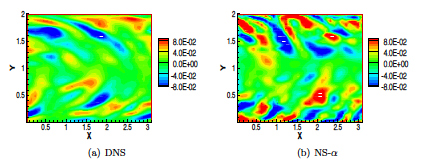Parameterization of turbulent eddies
The phenomenological view of three-dimensional turbulence is that the energy is transferred from large to small scales through the stretching and tilting of eddies, until the eddies become so small that they can no longer withstand viscous forces and are dissipated into heat. When carrying out computations of turbulence we are practically limited in the range of scales that can be computed. Typically, the smallest scales are not computed directly, and instead the role of these scales is replaced with a model. The vast majority of these models add a dissipative term to the momentum equations.
The LANS-alpha or NS-alpha model is a different approach. The governing equations can be physically interpreted as arising from a smoothing of the velocity that advects and stretches the eddies, which limits the smallest scales that can be generated. However, the origins of the model are rigorous, in that the equations are derived from first principles using Hamilton's principle through the averaging of particle trajectories.
While the equations themselves possess a number of interesting properties, the work I have done has been in applying these equations to different problems in fluid mechanics. Specification of the model parameter, alpha, which represents a smoothing scale, is critical. This is an area I continue to explore, and am currently working on in the POP-alpha model developed at Los Alamos National Labs. This is a model used for simulations of the global ocean. The POP-alpha model has been shown by the team at Los Alamos to be capable of producing energy levels at a coarse grid resolution (0.8 degrees) that requires a fine resolution (0.2 degrees) without the model - which makes it an excellent candidate for coarse grid global climate simulations.
One of the key questions in ocean modelling that is relevant today concerns the role of eddies in the Arctic, and whether the heat these eddies can transfer from the ocean to the ice is contributing to the decrease in sea ice extent and the sea ice thickness. This is a difficult problem because the size of the eddies which transfer heat in the ocean decreases with increasing latitude, so fine numerical meshes are required to capture the eddies in the Arctic. It is hoped that the NS-alpha model can alleviate this constraint as it has been shown to produce strong eddies at coarse resolution in several studies. In particular, the NS-alpha model equations have been shown to allow baroclinic instability to occur at a lower wave number than the Navier-Stokes equations, without requiring additional energy to be input to the system (unlike viscosity based approaches).
I am currently working with the NS-alpha model within a team of Canadian researchers studying the Labrador Sea, under a project entitled VITALS (Ventilation, Interactions and Transports Across the Labrador Sea). As part of this project we will be putting the NS-alpha model into the NEMO ocean code and assessing it's performance in capturing the role of eddies in deep-water convection.
The picture below is a snapshot of spanwise velocity in a turbulent channel (xy plane). It can be seen that the NS-alpha model produces a flow with structures comparable to those in a direct numerical simulation (DNS) - and even slightly more vigorous. Specification of the model parameter is key to producing a realistic flow.

I have also done some work applying the NS-alpha model to 3D recirulating flows. I found that in a cavity flow the model changes the vortices which arise due to an instability of the concave shear layer in the cavity. I developed a method to specify the model parameter as a function of the flow conditions, enabling it to be used in complex flows.
I am currently working with the NS-alpha model within a team of Canadian researchers studying the Labrador Sea, under a project entitled VITALS (Ventilation, Interactions and Transports Across the Labrador Sea). As part of this project we have implemented the NS-alpha model into a coupled ice-oceam model (NEMO+LIM) and are currently assessing it's performance in capturing the role of eddies in deep-water convection.
Selected Publications
K. Scott and F. Lien (2010), Application of the NS-alpha model to a recirculating flow, Flow, Turbulence and Combustion 84, p. 167-192.
K. Scott and F. Lien (2010), A derivation of the NS-alpha model and preliminary application to plane channel flow, Journal of Turbulence 11, N31, p1-26.